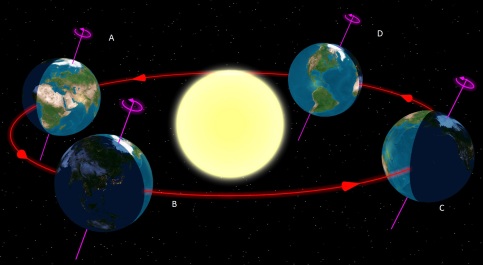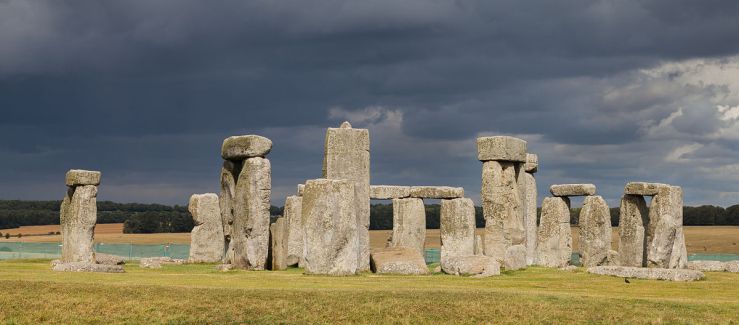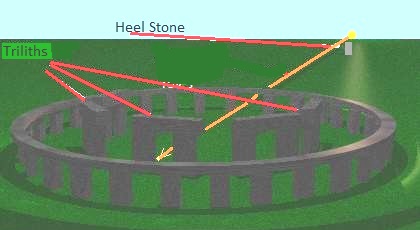This year, the June solstice will fall on 21 June. In the northern hemisphere, it is the day when there is the most daylight and when the Sun is at its highest in the midday sky.
Sunrise at the solstice at Stonehenge, England – image from Wikimedia commons
The origin of the word solstice is from two Latin words: sol, which means Sun, and sistere, to stand still. This is because, at the time of the solstice, the Sun stops getting higher, appears to stand still at the same height for a few days, and then gets lower in the midday sky.
The graph below shows the maximum height, or elevation, of the Sun, measured in degrees above the horizon, during the month of June. The graph is for a location 50 degrees latitude North, which is the same latitude as the southern tip of the British Isles.
The fact that the Sun’s elevation changes gradually means the amount of daylight also changes very little around the solstice. This is shown in the table below, which gives the sunrise and sunset times and the amount of daylight in hours, minutes and seconds for June in London.
Table of sunrise and sunset times for London (Time and Date 2018).
Precise definition of the solstice
The diagram above shows the Earth’s orbit around the Sun. For clarity the sizes of the Earth and Sun have been greatly exaggerated.
.
- During June, marked as Ain the diagram, the Earth’s North Pole is tilted towards the Sun and the days are longer in the northern hemisphere.
- During December, marked as Cin the diagram, the Earth’s South Pole is tilted towards the Sun and days are longer in the southern hemisphere.
- At points Band D, known as the equinoxes, neither pole is tilted towards the Sun and the amounts of daylight in the northern and southern hemisphere are equal.
The precise astronomical definition of the June solstice (also called the summer solstice in the northern hemisphere) is the exact point in time when the North Pole is tilted furthest towards the Sun. The times for this event for the years 2016-2020 are given in the table below – in GMT, in Tokyo time (which is 9 hours ahead of GMT) and in Hawaiian time (which is 10 hours behind GMT).
As you can see, the time of the solstice varies from year to year. It can fall on 20, 21 or 22 June, depending on your longitude (and thus your time zone).
Importance of the solstice to early man
The solstice was of great importance to early man, and many prehistoric sites appear to have been built to celebrate it. The most famous of these is Stonehenge, which is located in Wiltshire, England. It is a set of concentric stone circles built between 4000 and 5000 years ago. It was an amazing feat of construction for stone age man. The stone circle is over 30 metres in diameter. The largest stones are more than 9 metres tall, weigh over 25 tonnes and were hauled over 30 km to the site. It is reckoned that the smaller stones were moved from western Wales, a distance of 225 km (Jarus 2014).
Image from Wikimedia commons
At the centre of Stonehenge is a horseshoe arrangement of five sets of arches called triliths, each containing three stones. The open side of the horseshoe points North East towards a large stone 80 metres away from the main circle. Today this large stone is given the name ‘The Heel Stone’.
.
Image from Wikimedia commons
The monument is arranged in such a way that, for a few days either side of the June solstice and only at those dates, someone standing in the centre of the horse shoe and facing North East will see the Sun rise over the Heel stone.
How sunrise at the summer solstice at Stonehenge would have looked after the monument’s construction.
It is amazing that prehistoric man built such a large monument to line up with the June solstice. It clearly must have been a major event for a people living outdoors with only natural daylight, and in fact the solstice is still celebrated at Stonehenge today. Modern groups with ancient origins, such as Druids and Pagans, who revere the natural world more than many modern humans, join approximately 30,000 people who flock to Stonehenge to watch the Sun rise at the solstice each year.
Interestingly, to prevent damage to such an important ancient monument it is not normally possible to get right up to the stones. However, the charity which manages the site English Heritage open it up every year for the solstice, giving people a rare chance to get up close.
For the BBC report on the 2017 Stonehenge solstice celebrations click on the link below.
https://www.bbc.co.uk/news/uk-england-wiltshire-40352528
The southern hemisphere
To those of you who live in the southern hemisphere the June solstice is the winter solstice, when the midday Sun is at its lowest in the sky. After the solstice the days start getting gradually longer and the nights gradually shorter, although the change doesn’t really become noticeable until July.
Note
Strictly speaking it isn’t true that for the whole northern hemisphere the midday Sun is at its highest in the sky on the solstice. At the Tropic of Cancer, which is 23.5 degrees north, and is shown as the upper red line in diagram below, the Sun is directly overhead at midday on the June solstice. At low latitudes between the equator and the Tropic of Cancer the Sun is directly overhead at midday on two dates either side of the solstice. For example, in San Juan, Puerto Rico, which lies 18.5 degrees North of the equator, the Sun is overhead at midday on May 13 and July 30.
.
References
Jarus, O (2014) Stonehenge: Facts & Theories About Mysterious Monument, Available at: http://www.livescience.com/22427-stonehenge-facts.html(Accessed: 10 June 2016).
Time and Date (2018) London, ENG, United Kingdom — sunrise, sunset, and daylength, June 2018, Available at: http://www.timeanddate.com/sun/uk/london(Accessed: 4 June 2018).










[…] Source link […]
LikeLike
I get the heel stone alignment at Stonehenge but as the actual point on the horizon where the sun rises hardly changes over days it does seem a bit imprecise to an actual day. Maybe that is why the festival at Christmas extends over 12 days.
LikeLike
`Very interesting article, thank you for sharing 🙂
LikeLike
Great information!
LikeLike
Thank you
LikeLike
Nice job! I like the details, graphs, and pictures. Very interesting!
LikeLiked by 1 person
Thank you
LikeLike
[…] Science Geek has all the detail you’re likely to need about next week’s solstice, including maps, […]
LikeLike
‘Stone-age’ humans were a whole lot more sophisticated and widely-traveled than most 21st Century humans give them credit for.
LikeLiked by 2 people
Very true !!
LikeLiked by 1 person
Yes I think you should do this. You should also post them to your blog, when you have a full set of images over the entire year.
LikeLiked by 1 person
The front window of my house faces east. Rooftops across the street serve as markers of the Sun’s progress from season to season. I ought to take photos at the solstices and equinoxes plus each month. It would make an interesting series.
LikeLiked by 3 people